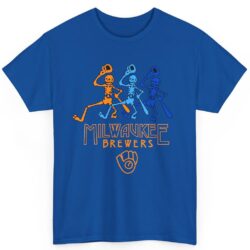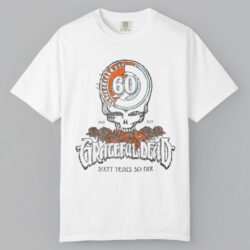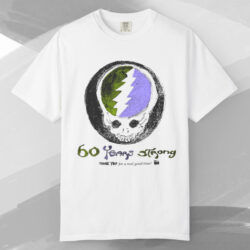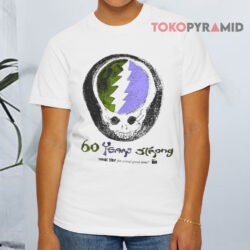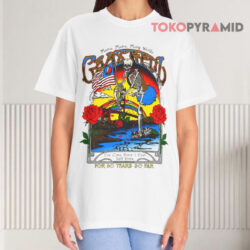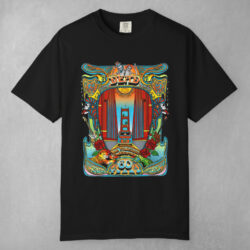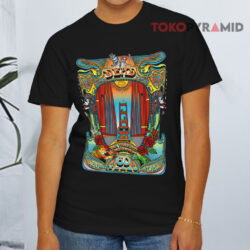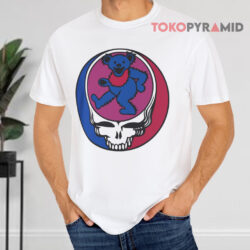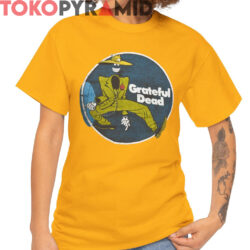No products in the cart.
Grateful Dead
Grateful Dead: How a Psychedelic Rock Band Became a Cultural Phenomenon
The Grateful Dead was an American rock band that formed in 1965 and quickly became one of the most influential bands in music history. They were known for their improvisational live shows and their unique mix of rock, folk, blues, and psychedelic music. The Grateful Dead broke the rules of traditional music, and their impact on the music industry, culture, and their devoted fan base, known as Deadheads, is still felt today.
In this exploration of the Grateful Dead, we will look at the band’s amazing journey, their signature sound, and their unmatched influence on the world of music.
I. The History of the Grateful Dead
The origins and early opportunities of the band.
The Grateful Dead started humbly, but they went on to become one of the most legendary bands of all time. The band formed in the mid-1960s in the vibrant music scene of San Francisco’s Haight-Ashbury district, a time of social upheaval, cultural revolution, and experimentation. This eclectic and free-spirited environment was the perfect breeding ground for the Grateful Dead.
The core members of the band were Jerry Garcia, Bob Weir, Phil Lesh, Ron “Pigpen” McKernan, and Bill Kreutzmann. These musicians came together because of their shared love for different kinds of music, including blues, folk, bluegrass, and rock ‘n’ roll. The counterculture movement and the desire to explore new musical horizons were also big influences on the band.
One of the band’s early opportunities came when they became the house band for Ken Kesey’s infamous, Acid Tests. These experimental gatherings featured the use of LSD and multimedia performances, and they played a crucial role in shaping the band’s improvisational style and ethos. The Acid Tests not only exposed the Grateful Dead to a growing audience but also cemented their reputation as pioneers of the psychedelic music scene.
In 1967, the band released their self-titled debut album, The Grateful Dead. While the album wasn’t a commercial success, it showcased their distinctive sound and laid the foundation for their future musical explorations.

The Grateful Dead’s early years were marked by constant evolution and experimentation, both musically and culturally. They thrived on improvisation and pushed the boundaries of what a live concert experience could be. These formative years set the stage for their enduring legacy and their journey to become one of the most influential bands in rock history.
The evolution of Grateful Dead’s music and style across different phases.
The Grateful Dead’s musical journey can be divided into distinct phases, each with its own unique style and creative direction. Their ability to evolve and adapt while staying true to their core identity is why they are still so popular today. Let’s take a look at these key phases in the evolution of their music and style:
- Psychedelic Pioneers (1960s): The band’s early years were heavily influenced by the psychedelic movement of the 1960s. Their music during this phase was characterized by long improvised jams, intricate psychedelic arrangements, and cryptic lyrics. Albums like Anthem of the Sun and Aoxomoxoa are perfect examples of their experimentation with unusual song structures and studio techniques.
- Americana and Folk Influences (Early 1970s): In the early 1970s, the Grateful Dead moved towards a more roots-oriented sound. Their album American Beauty is a great example of this phase, featuring folk-rock and country-inspired songs like Truckin‘ and Ripple. This period showed that they could incorporate different musical elements into their repertoire.
- Jazz and Fusion Exploration (Mid 1970s): During the mid-1970s, the band delved into jazz and fusion influences, resulting in complex and exploratory live performances. Albums like Blues for Allah featured intricate instrumental compositions, which was a departure from their earlier psychedelic sound.
- Return to Roots and Blues (Late 1970s-1980s): In the late 1970s and early 1980s, the Grateful Dead returned to their blues and rock roots. Live shows became more structured, with an emphasis on tighter song arrangements. Their album In the Dark (1987) produced their first and only Top 40 hit, Touch of Grey.
- Farewell Tour and Legacy (1990s): The 1990s brought both challenges and triumphs for the Grateful Dead. The band embarked on their Fare Thee Well tour in 1995, marking the 30th anniversary of their formation. It was a bittersweet farewell, as Jerry Garcia passed away shortly thereafter. However, the legacy of the Grateful Dead lived on through the surviving members and a dedicated fanbase.
- Post-Garcia Era (2000s-Present): In the post-Garcia era, the living members continued to perform together under different names like The Dead and Dead & Company. These projects have allowed them to reinterpret the Grateful Dead’s catalog while bringing new energy to their live performances.
Throughout these phases, the Grateful Dead’s music and style evolved, reflecting the changing landscape of both their journeys and the broader music scene. Their ability to adapt and remain relevant over the decades is a testament to the timeless and enduring nature of their music.
The Lives and Departures of Prominent Band Members
The Grateful Dead’s history is marked not only by their music but also by the lives and departures of several prominent band members. These individuals played crucial roles in shaping the band’s sound and legacy. Let’s take a closer look at some of the key members and their contributions:
- Jerry Garcia (1942-1995): Jerry Garcia, the band’s lead guitarist and primary vocalist, was the face of the Grateful Dead. His intricate guitar work, soulful vocals, and songwriting prowess were central to the band’s identity. Jerry’s untimely passing in 1995 was a profound loss to the world of music, leaving a void that could never be filled.
- Ron “Pigpen” McKernan (1945-1973): Ron “Pigpen” McKernan was the band’s original keyboardist and one of its founding members. He was known for his bluesy vocals and contributions to the early sound of the Grateful Dead. Tragically, Pigpen’s struggles with alcoholism led to his early departure from the band and his passing at the age of 27.
- Brent Mydland (1952-1990): Brent Mydland joined the Grateful Dead as a keyboardist and vocalist in 1979, bringing fresh energy to the band. His passionate singing and songwriting added a new dimension to the band’s music. Sadly, Brent passed away in 1990, marking another loss for the Grateful Dead community.
- Keith Godchaux (1948-1980) and Donna Godchaux: Keith Godchaux served as the band’s keyboardist from 1971 to 1979, during a period of significant musical evolution. His wife, Donna Godchaux, joined as a vocalist during the same time. They contributed to the band’s harmonies and creative direction before departing in 1979.
- Phil Lesh, Bob Weir, and Bill Kreutzmann: Phil Lesh (bass), Bob Weir (rhythm guitar), and Bill Kreutzmann (drums) are three original members who remained with the Grateful Dead throughout its existence. Their enduring commitment to the band ensured its continued existence and growth.

The departures and transitions of these prominent band members were pivotal moments in the Grateful Dead’s history. Each change in the lineup brought new dynamics to the music and influenced the band’s evolving sound. Despite the challenges and losses, the Grateful Dead’s dedication to their craft and their fans endured, ensuring the band’s legacy lives on through their music and the ongoing performances of surviving members in various musical projects.
II. Woodstock and the Rise to Fame
The Grateful Dead’s iconic performance at the 1969 Woodstock Music and Art Fair was a watershed moment in their journey to fame. Woodstock, a historic music festival held in Bethel, New York, became synonymous with the counterculture movement of the 1960s, and the Grateful Dead’s participation in the event cemented their status as musical legends.
In the summer of 1969, the Grateful Dead were at their creative peak. Their unique blend of improvisational rock and psychedelic sound had garnered a devoted following, making them a perfect fit for Woodstock’s eclectic lineup. However, their path to Woodstock was not without its challenges. Logistical issues caused the band to arrive late at the festival, and they were scheduled to perform in the early hours of the morning.
Despite these challenges, the Grateful Dead’s performance at Woodstock was nothing short of extraordinary. They took the stage at 10:30 AM on Sunday, August 17, 1969, and played a set that lasted over two hours. Their music resonated with the thousands of festival-goers who had braved the rain, mud, and chaos of Woodstock.
During their set, the Grateful Dead performed classics like Dark Star, St. Stephen, and Morning Dew, captivating the audience with their improvisational jams and ethereal soundscapes. The band’s ability to create a sense of unity and connection with the audience was truly remarkable and exemplified the spirit of Woodstock.

The Grateful Dead’s performance at Woodstock catapulted them into the mainstream consciousness. While they already had a dedicated fanbase, Woodstock exposed their music to a much larger audience and solidified their reputation as a band that transcended musical boundaries. Woodstock marked a turning point in their career and played a pivotal role in their rise to fame.
III. Music and Famous Songs
Iconic Grateful Dead Songs and the Stories Behind Them
The Grateful Dead’s vast discography is a treasure trove of iconic songs, each with its own unique story and significance. Here is a closer look at some of their most famous tracks and the narratives behind them:
- Truckin’ (1970): This iconic song captures the spirit of the Grateful Dead’s nomadic lifestyle, with lyrics that reflect the trials and tribulations of life on the road. It has become an anthem for the band and their fans alike, celebrating the shared experience of the journey.
- Ripple (1970): This gentle, introspective folk-rock song explores the interconnectedness of life and the impact of our actions. Its profound message and timeless melody have made it a favorite among fans of all ages.
- Casey Jones (1970): This high-energy blues track is a tribute to the legendary railroad engineer Casey Jones. Its driving rhythm and catchy lyrics make it a crowd-pleaser at live shows.
- Sugar Magnolia (1970): This upbeat love song captures the spirit of the 1970s with its catchy melody and infectious optimism. It’s a beloved staple in the Grateful Dead’s live repertoire.
- Friend of the Devil (1970): This folk-rock tune weaves a tale of a man on the run from the law, evoking a sense of adventure and intrigue. Its blend of folk and bluegrass elements showcases the band’s versatility.
- Terrapin Station (1977): This epic, multi-part suite showcases the Grateful Dead’s progressive rock influences. Its intricate composition and ethereal lyrics have made it a favorite among fans of the band’s more complex work.
- Uncle John’s Band (1969): This harmonious, folk-rock song celebrates the power of music to bring people together. It’s an anthem for the Grateful Dead community and a testament to the band’s ability to create a sense of camaraderie among their fans.
Each of these songs represents a different facet of the Grateful Dead’s musical style, yet they are all united by their timeless quality and enduring appeal. The band’s diverse catalog continues to resonate with fans old and new, reflecting their lasting impact on the world of music and the power of storytelling.
Their Unique Music Style and Fusion of Diverse Musical Elements
The Grateful Dead’s music is renowned for its eclectic style, defying easy categorization. At its core, their sound is rooted in rock, but it incorporates a rich tapestry of influences from various musical genres, including:
- Psychedelic Rock: The Grateful Dead emerged during the height of the psychedelic rock era in the 1960s. Their early music incorporated the trippy and experimental elements characteristic of the time. Songs like Dark Star and China Cat Sunflower featured extended instrumental jams, echoing the mind-expanding experiences of the era.
- Folk and Americana: In the early 1970s, the Grateful Dead shifted toward folk and Americana influences. Albums like American Beauty and Workingman’s Dead showcased their ability to craft melodic, country-tinged songs. This phase highlighted their harmonious vocal arrangements and heartfelt storytelling.
- Blues and Improvisation: The Grateful Dead’s roots in blues are evident in their music, especially during their live performances. They often ventured into blues jams, allowing improvisation to take center stage. Songs like Turn On Your Love Light and Smokestack Lightning were infused with bluesy elements, showcasing the band’s improvisational prowess.
- Jazz and Fusion: During the mid-1970s, the Grateful Dead embraced jazz and fusion influences. This era saw them experiment with complex time signatures and intricate instrumental compositions. The album Blues for Allah is a prime example of their fusion explorations, featuring intricate instrumental passages and progressive song structures.
- Bluegrass and Country: The band’s incorporation of bluegrass and country elements added depth to their sound. Songs like Friend of the Devil and Cumberland Blues featured acoustic instruments like the banjo and pedal steel guitar, infusing a rootsy, down-home feel into their music.
- World Music: The Grateful Dead was also known for their openness to world music influences. They occasionally incorporated instruments and rhythms from different cultures into their performances, creating a global fusion of sounds.
What set the Grateful Dead apart was their ability to seamlessly blend these diverse musical elements into a cohesive and ever-evolving sound. Their live shows were especially known for their unpredictability, with each performance presenting a unique musical journey. Their willingness to take risks and explore new territory made them pioneers in the fusion of musical styles.
Ultimately, the Grateful Dead’s music transcended genre labels and their eclectic approach attracted a diverse and dedicated fanbase. Their ability to connect with audiences on a deep, emotional level through their unique musical language is a testament to their enduring legacy in the world of music.
The Grateful Dead’s music was a melting pot of different genres, but it was always unified by their passion for improvisation and their commitment to creating a unique sound that was all their own. They were true pioneers of musical fusion, and their legacy continues to inspire artists today.
III. Influence and Fanbase
The Deadheads
The Grateful Dead’s extraordinary fan community, affectionately known as Deadheads, is a testament to the band’s commitment to fostering a unique and inclusive environment for their fans. Here’s a look at how they created this special bond:
The Birth of Deadheads: From the band’s early days, a devoted following began to form around the Grateful Dead. These fans were drawn to the band’s music, ethos, and sense of belonging. Over time, this dedicated group of enthusiasts would come to be known as Deadheads.
The Magic of Live Shows: The Grateful Dead’s live performances were a cornerstone of their appeal. Each show was a unique experience, with the band’s improvisational jams, extended solos, and vibrant energy creating an atmosphere unlike any other. This encouraged fans to follow the band on tour, sometimes for entire tours or even entire careers.
Inclusivity and Acceptance: The Grateful Dead welcomed fans from all walks of life, creating an atmosphere of inclusivity and acceptance. Deadhead culture emphasized communal values, and fans often formed strong connections with one another. This sense of belonging extended beyond the music and was central to the Deadhead experience.
Fan-Centric Policies: The band implemented fan-friendly policies, such as allowing fans to record their live performances. This open-minded approach not only contributed to the vast archive of Grateful Dead concert recordings but also empowered fans to feel like active participants in the band’s journey.
Fan Art and Iconography: Deadheads were encouraged to express their creativity through fan art, tie-dye clothing, and other forms of artistic expression. The band’s iconic imagery, including the Steal Your Face logo, became symbols of the community’s shared identity.
Philanthropy and Social Causes: The Grateful Dead were also known for their commitment to philanthropy and social causes. They engaged in various charitable activities, including benefit concerts, to support causes they believed in.

Continuing the Legacy: Even after Jerry Garcia’s passing in 1995, the surviving members of the Grateful Dead remained dedicated to their fans. They continued to perform together in various configurations, including The Other Ones and Dead & Company, ensuring that the music and spirit of the Grateful Dead lived on.
The Grateful Dead’s devotion to their fans transcended the typical musician-fan relationship. They recognized the profound impact their music had on their fans’ lives and embraced the reciprocal love and support they received. This unique bond between the band and their fans created a community like no other in the world of music, where the love of the music and the love for one another intertwined to form a lasting legacy that endures to this day.
Related topic: Have Deadhead Friends? They Will Love These 10 Vintage Grateful Dead Shirts
How did the Grateful Dead inspire other artists?
The Grateful Dead’s influence on the music industry is immeasurable. Their innovative approach to music and their unique ethos have inspired countless artists across genres. Here’s a look at how the Grateful Dead left an indelible mark on other musicians and creative minds:
- Pioneering the Jam Band Scene: The Grateful Dead were trailblazers in the jam band scene, and their improvisational style set the stage for many other jam bands to follow. Bands like Phish, Widespread Panic, and The String Cheese Incident drew inspiration from the Dead’s live performances, incorporating extended jams and improvisation into their own music.
- The Fusion of Genres: The Grateful Dead’s ability to seamlessly blend diverse musical genres, from rock and blues to folk and jazz, inspired artists to explore similar fusion. Bands like The Allman Brothers Band and Gov’t Mule incorporated elements of blues, rock, and improvisation into their music, following the Grateful Dead’s lead.
- A Sense of Community: The Dead’s emphasis on building a fan community left a lasting impression. Artists like Dave Matthews Band and Pearl Jam have fostered dedicated fan bases and created a sense of togetherness at their shows, much like the Grateful Dead did.
- Musical Experimentation: The Grateful Dead’s fearless experimentation in the studio and on stage inspired musicians to push the boundaries of their own creativity. Bands like Radiohead and Wilco embraced experimentation in their music, taking risks and evolving their sound over time.
- Freedom in Live Performance: The Dead’s live performances were renowned for their freedom and unpredictability. Artists such as Phish and My Morning Jacket have embraced the idea of each live show as a unique experience, allowing for improvisation and spontaneity.
- Tapping into Psychedelia: The Grateful Dead’s association with psychedelic music influenced subsequent generations of musicians exploring psychedelic and trippy sounds. Bands like The Flaming Lips and Tame Impala have drawn from this psychedelic wellspring.
- Covering Grateful Dead Songs: Many artists have paid tribute to the Grateful Dead by covering their songs. From Bruce Hornsby to The Black Crowes, these covers help keep the band’s music alive and introduce it to new audiences.
- Lyrics and Storytelling: The Grateful Dead’s lyrical storytelling and cryptic, poetic lyrics have influenced songwriters across genres. Artists like John Mayer, who later joined Dead & Company, have acknowledged the impact of the band’s songwriting on their own work.
- Tolerance and Acceptance: The Grateful Dead’s commitment to tolerance and acceptance inspired artists to use their platform to advocate for social change and unity. Musicians like Bob Dylan and Neil Young have championed social and political causes, following in the Dead’s footsteps.
In essence, the Grateful Dead’s legacy is not confined to their music alone; it’s a cultural phenomenon that has shaped the ethos of generations of artists. Their emphasis on musical exploration, community, and the boundless possibilities of live performance continues to influence musicians and creative minds around the world. The Grateful Dead’s enduring impact is a testament to their status as musical pioneers and cultural icons.
The Grateful Dead’s influence is truly profound, and it can be seen and heard in the music of countless artists today. Their legacy is a testament to their power as musicians and their impact on the culture.
IV. Grateful Dead’s next era
After the Grateful Dead’s temporary hiatus in the mid-1990s following Jerry Garcia’s passing, the surviving members pursued a variety of musical projects and activities that allowed them to continue their creative journey and connect with fans. Here’s a look at what the living members of the Grateful Dead have been up to:
- Phil Lesh: The bassist has remained active in the music scene, forming Phil Lesh and Friends, a project that features rotating lineups of talented musicians performing Grateful Dead classics and original material. Lesh’s dedication to keeping the music alive has made him a beloved figure in the post-Grateful Dead era.
- Bob Weir: The band’s rhythm guitarist and vocalist formed RatDog, a band that continued to explore the Grateful Dead’s catalog while introducing new material. He also collaborated with other musicians, including bassist Rob Wasserman and members of Phish, further extending his musical reach.
- Bill Kreutzmann: The drummer continued to play music in various capacities, forming bands like BK3 and 7 Walkers and occasionally joining Phil Lesh and Friends for performances. His rhythmic talents ensured that the spirit of the Grateful Dead lived on in his music.
- Mickey Hart: The percussionist embarked on a diverse range of musical ventures, including solo projects and collaborations with world music artists. He also explored the intersection of music and science, delving into the study of rhythm and the healing power of music.
- Bruce Hornsby: The keyboardist, who had frequently played with the Grateful Dead in the 1990s, continued to pursue his own solo career. His distinctive piano and songwriting style found success in both the rock and adult contemporary genres.
- Dead & Company: In 2015, a new era for Grateful Dead music began with the formation of Dead & Company. This project featured surviving members Bob Weir, Mickey Hart, and Bill Kreutzmann, alongside renowned musicians John Mayer, Oteil Burbridge, and Jeff Chimenti. Dead & Company’s live performances paid homage to the Grateful Dead’s catalog while infusing fresh energy and interpretation into the music. Unfortunately, Dead and Company just announced Summer 2023 Tour will be the group’s last.
- Philanthropy and Activism: Several members of the Grateful Dead have been involved in philanthropic and environmental activism. Phil Lesh and Bob Weir, for instance, have supported various charitable causes and used their platforms to raise awareness about social and environmental issues.
- Ongoing Tours and Festivals: Many of the surviving members have continued to tour individually or as part of various bands, keeping the spirit of live music alive. They have also made appearances at festivals and special events, connecting with fans and introducing their music to new generations.

The living members of the Grateful Dead have demonstrated a remarkable dedication to their craft and their fans, ensuring that the music and ethos of the band persist long after their original incarnation. Through their solo projects, collaborations, and continued live performances, they have kept the Grateful Dead’s legacy alive while forging their own musical paths.
V. Final conclusion
In conclusion, the Grateful Dead’s musical journey, from their Woodstock breakthrough to the present day, stands as a testament to their enduring influence. Their eclectic sound, improvisational prowess, and commitment to fostering a unique fan community have left an indelible mark on the music world.
While the band itself may have gone through phases and changes, the spirit of the Grateful Dead lives on in the hearts of devoted Deadheads and continues to inspire musicians across genres. The surviving members’ dedication to keeping the music alive and their ongoing projects ensure that the Grateful Dead’s legacy remains vibrant and relevant.
For those interested in experiencing the magic of the Grateful Dead, we encourage you to join the passionate community of fans and stay connected with the latest updates on their musical endeavors. The Grateful Dead’s enduring journey is a testament to the timeless power of music to unite, inspire, and transcend generations.



